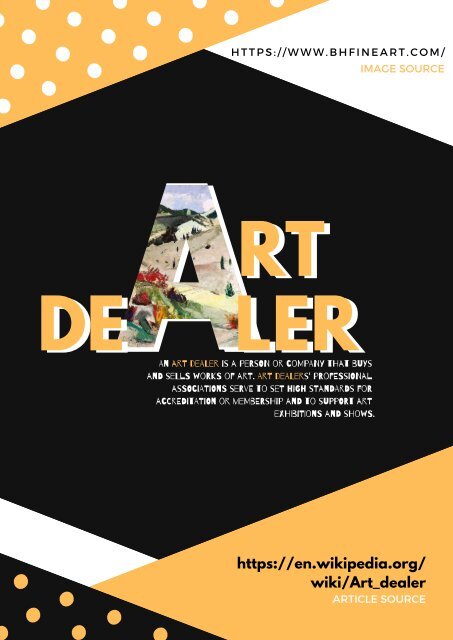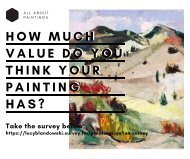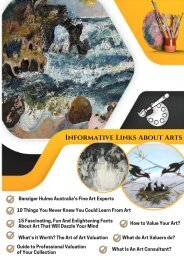Art Dealer
Art dealers often study the history of art before entering on their careers. Related careers that often cross-over include curators of museums and art auction firms are industry-related careers. Gallery owners who do not succeed may seek to work for more successful galleries. Others pursue careers as art critics, academics, curators of museums or auction houses, or practicing artists.
Art dealers often study the history of art before entering on their careers. Related careers that often cross-over include curators of museums and art auction firms are industry-related careers. Gallery owners who do not succeed may seek to work for more successful galleries. Others pursue careers as art critics, academics, curators of museums or auction houses, or practicing artists.
Create successful ePaper yourself
Turn your PDF publications into a flip-book with our unique Google optimized e-Paper software.
H T T P S : / / W W W . B H F I N E A R T . C O M /<br />
IMAGE SOURCE<br />
RT<br />
DE<br />
LER<br />
An arT deALer is a peRsON or coMpANy tHat buYs<br />
anD seLlS woRkS of arT. ArT deALers' pRofESsiONal<br />
asSOciATiOnS seRvE to seT hiGh sTanDArDs foR<br />
acCrEDitATiOn or meMbERsHip anD to suPpORt arT<br />
exHIbiTIonS anD sHowS.<br />
https://en.wikipedia.org/<br />
wiki/<strong>Art</strong>_dealer<br />
ARTICLE SOURCE
art dealer typically seeks out various artists to represent, and builds relationships with collectors and museums whose<br />
An<br />
are likely to match the work of the represented artists. Some dealers are able to anticipate market trends, while some<br />
interests<br />
dealers may be able to influence the taste of the market. Many dealers specialize in a particular style, period, or<br />
prominent<br />
They often travel internationally, frequenting exhibitions, auctions, and artists' studios looking for good buys, little-<br />
region.<br />
treasures, and exciting new works. When dealers buy works of art, they resell them either in their galleries or directly to<br />
known<br />
Those who deal in contemporary art usually exhibit artists' works in their galleries, and take a percentage of the<br />
collectors.<br />
dealers often study the history of art before entering on their careers. Related careers that often cross-over<br />
<strong>Art</strong><br />
curatorsof museums and art auction firms are industry-related careers.[1] Gallery owners who do not succeed may seek<br />
include<br />
work for more successful galleries. Others pursue careers as art critics, academics, curators of museums or auction houses,<br />
to<br />
practicing artists.[3]<br />
or<br />
have to understand the business side of the art world. They keep up with trends in the market and are knowledgeable<br />
<strong>Dealer</strong>s<br />
the style of art people want to buy. They figure out how much they should pay for a piece and then estimate the resale<br />
about<br />
They are also often passionate and knowledgeable about art. Those who deal with contemporary art promote new<br />
price.<br />
creating a market for the artists' works and securing financial success for themselves. The art world is subject to<br />
artists,<br />
booms and bust just like any other market. <strong>Art</strong> dealers must be economically conscious in order to maintain their<br />
economic<br />
The mark ups of art work must be carefully monitored. If prices and profits are too large, then investments may be<br />
livelihoods.<br />
determine an artwork's value, dealers inspect the objects or paintings closely, and compare the fine details with similar<br />
To<br />
Some dealers with many years of experience learn to identify unsigned works by examining stylistic features such as<br />
pieces.<br />
strokes, color, form. They recognize the styles of different periods and individual artists. Often art dealers are able to<br />
brush<br />
authentic works from forgeries (although even dealers are sometimes fooled).<br />
distinguish<br />
Forchondt the Elder (1608–1678)<br />
Guillam<br />
17th century Flemish Baroque painter and art dealer based in Antwerp. He established an important art dealing business<br />
A<br />
international connections in Europe maintained by his extended family. He originally trained as a painter and cabinet<br />
with<br />
but built a reputation through his international art business. His children became art dealers who settled in various<br />
maker<br />
in Europe such as Venice, Paris, Vienna, Prague, Linz, Passau and Cadiz where they supplied an elite clientele with a<br />
cities<br />
of art objects. When in the 1670s Flanders suffered a severe economic downturn due mostly to an invasion by the<br />
variety<br />
Guillam Forchondt and his brother Melchior the Younger became art entrepreneurs by hiring lesser painters to create<br />
French,<br />
projects such as large commissioned copies of famous works or large decorative objects. At one point, the Brothers<br />
group<br />
Musson (Antwerp, 1598–3 November 1678)<br />
Matthijs<br />
painter and art dealer based in Antwerp, who helped popularize artists of the 17th century Antwerp school by marketing<br />
A<br />
throughout Europe.[6] Many of his correspondences have been published and studies of his business relationships with<br />
them<br />
dealers across Europe have established ideas about the art trade and its economics<br />
other<br />
RolE<br />
price the works sell for.[2]<br />
Job<br />
reQUirEMenTs<br />
devalued should an overstock or economic downturn occur.[4]<br />
NotABle arT<br />
deALerS<br />
Forchondt had 60 painters in service for export to France, Austria, Spain and Portugal.[5]
Gagosian (born 1945)<br />
Larry<br />
of the multimillion-dollar Gagosian Gallery group.<br />
Head<br />
Glimcher (born 1938)<br />
Arne<br />
is the founder of The Pace Gallery and is widely known as one of the art world's most powerful dealers. The Pace<br />
Glimcher<br />
represents contemporary artists including Chuck Close, Tara Donovan, David Hockney, Maya Lin and Kiki Smith. It also<br />
Gallery<br />
the estates of several artists, including Pablo Picasso, Agnes Martin, Ad Reinhardt, and Alexander Calder.[8] During<br />
represents<br />
career he has worked closely with important artists including Jean Dubuffet, Robert Rauschenberg, Louise Nevelson,<br />
his<br />
Lucas Samaras. In 2007, Glimcher received the Distinguished Alumni Award from the Massachusetts College of <strong>Art</strong> and<br />
and<br />
Halpert (1900–1970)<br />
Edith<br />
was born in 1900 in Odessa, arrived in the U.S. as a penniless Russian Jewish immigrant and grew to become a<br />
Halpert<br />
New York City art dealer, transforming the landscape of Modern art. Over her forty-year career from 1926 through<br />
pioneering<br />
1960s, Halpert brought recognition and market success to many avant-garde American artists. Her establishment The<br />
the<br />
Gallery, one of the first in Greenwich Village, introduced and showcased many modern art luminaries. Halpert died<br />
Downtown<br />
age 70 a multimillionaire, with Sotheby's crediting her with having put modernist painting auctions on the map. Its<br />
at<br />
Perls<br />
Klaus<br />
(1912–2008) was born and raised in Berlin. He studied art history in Munich, but was forced to finish his education in<br />
Perls<br />
Switzerland, as the Nazis were no longer allowing degrees for Jews. He ran Perls Galleries for over 60 years. His gallery<br />
Basel,<br />
with contemporary American artists, modern works from the School of Paris and Mexican and South American art. Perls<br />
dealt<br />
developed an interest in art from Benin and built a sizable collection. He was not only an art dealer, but also a donor as he<br />
also<br />
many significant works of art to the Metropolitan Museum of <strong>Art</strong>. He died June 2, 2008 in Mount Kisco, N.Y. at age<br />
contributed<br />
Hopkins Struever<br />
Martha<br />
was born in 1931 in Milan, Indiana. She attended the Tobé-Coburn School For Fashion Careers in New York City, after<br />
Struever<br />
her Bachelor of Science degree from Purdue University in Lafayette, Indiana in 1953. She began collecting and<br />
obtaining<br />
in American Indian art in 1971, and is regarded as a leading scholar on historic and contemporary Pueblo<br />
dealing<br />
pottery and Pueblo and Navajo Indian jewelry. She has authored books on Charles Loloma, the foremost American<br />
Indian<br />
jeweler, and Dextra Quotskuyva, the pre-eminent contemporary Hopi potter, as well as exhibition catalogues<br />
Indian<br />
Seligmann<br />
Jacques<br />
Seligmann (1858–1923) moved to Paris in 1874 where he set up an antiquarian business in 1880. Benefiting from<br />
German-born<br />
interest of clients such as Edmond de Rothschild, he moved to the Place Vendôme in 1900 and in 1904 opened an office in<br />
the<br />
York. In 1909, he acquired the Hôtel de Monaco in Paris where he was able to impress his more important clients such as<br />
New<br />
Russian Stroganoff family and the high-flying British politician Sir Philip Sassoon. In New York, he developed interest in<br />
the<br />
art attracting collectors such as Benjamin Altman, William Randolph Hearst and J. P. Morgan. On his death, his<br />
European<br />
Weber (1932-2008)<br />
John<br />
was born in 1932 in Los Angeles. He was a radio corpsman in the Navy during the Korean War before receiving a<br />
Weber<br />
degree from Antioch College in Yellow Springs, Ohio in 1958. As a contemporary art dealer, Weber was ahead of his<br />
bachelor's<br />
as he was one of the early promotors of Conceptual <strong>Art</strong>, Post-Minimalist sculpture and Italian <strong>Art</strong>e Povera. He was the<br />
time<br />
of several galleries throughout his career and helped organize shows that featured big names such as Robert<br />
director<br />
Richard Long and Andy Warhol. Weber died May 23, 2008 in Hudson, N.Y. at age 75.<br />
Indiana,<br />
Design.<br />
posthumous sale of her collection went for million in 1973.<br />
96.[9]<br />
on Hopi potter Iris Nampeyo and other Hopi art, and has guest curated museum shows in several cities.[10]<br />
son Germain Seligman continued to run Jacques Seligmann & Company.





